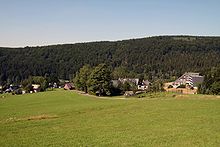Holzhau
|
Holzhau
Community Rechenberg-Bienenmühle
Coordinates: 50 ° 44 ′ 1 ″ N , 13 ° 35 ′ 19 ″ E
|
||
|---|---|---|
| Height : | 616 m | |
| Incorporation : | January 1, 1994 | |
| Postal code : | 09623 | |
| Area code : | 037327 | |
|
Location of Holzhau in Saxony |
||
Holzhau has been part of the municipality of Rechenberg-Bienenmühle in the Eastern Ore Mountains since 1994 .
Geographical location
The place is located in the Erzgebirge / Vogtland Nature Park in the valley of the Freiberg Mulde and its tributary Bitterbach, not far from the border with the Czech Republic . The Steinkuppe (806 m) in the southeast and the Drachenkopf (805 m) in the northeast are the third and fourth highest elevations in the Central Saxony district . The cross-border railway line Nossen – Moldau , which has ended here since 1972, ran through the town .
history
The hollow that flows through the village was already used in 1438 for rafting wood, which was urgently needed for mining in Freiberg and the surrounding area. In addition to fuel and mining timber which was produced by Köhler charcoal for the operation of the iron, melting and Seigerhütten needed. Mining, however, was hardly practiced in Holzhau and the surrounding area. The mining of Eisenstein was stopped again after a short time.
On July 8, 1534, Duke Georg von Sachsen bought from Caspar von Purschenstein the forest area in the area of the later village of Holzhau an der Böhmische Strasse, which at that time belonged to Rechenberg . At the same time, the Wettiner had the Freiberg Mulde ready for wood rafting again. Most of the acquired forest (later called Fischerwald) was cleared and the wood was removed . Already in 1536 the Lords of permitted Schoenberg as landlords to Einschlägern of wood (= loggers) the settlement on the Rodeland, the wood Hawe . A single row forest hoof village was created in which in 1551 there were already 24 possessed men and 33 residents. The place initially belonged to the Frauenstein manor and was added to the Electoral Saxon office of Frauenstein in the Erzgebirge in the 17th century .
The main occupation of the settlers was forestry and rafting. Up until the last third of the 19th century , the wood was rafted down to Freiberg. For this purpose, several ponds for intermediate stops and for flood protection were created along the way, some of which are still present today. The name of the Teichhaus district can be traced back to one of these ponds .
In 1790 there were 52 houses in the village, and at that time the residents had to do compulsory labor in Rechenberg before they were replaced in the 19th century. In Oberholzhau there was a Saxon customs office for the Ossegger Steig leading to Bohemia at Betteleck .
Due to the railway construction in the 19th century, numerous summer visitors came to the place. Richters Sommerfrische and Fischer's Gasthaus , both located directly at the forest, attracted numerous vacationers. In the 1930s, the “ Strength through Joy ” movement added additional accommodation facilities, and during the GDR era, several FDGB and company holiday homes were built in Holzhau. Immediately after 1990 the number of tourists fell. Several cross-border hiking trails and trails as well as two ski lifts can now be used for tourism. There are road border crossings in Neurehefeld and Deutschgeorgenthal . The place is also the end point of the Muldentalradwanderweg .
In 1994 the previously independent municipality of Holzhau gave up its independence and was incorporated into Rechenberg-Bienenmühle.
Development of the population
|
|
|
traffic
The connection to the road network is via the state road S 185, which connects Holzhau with Rechenberg-Bienenmühle and Neuhermsdorf .
The bus traffic is handled by REGIOBUS Mittelachsen GmbH. Bus routes connect Holzhau with Freiberg and Neuhausen / Erzgeb. (As of July 2013).
Holzhau is the end point of the Freiberg – Holzhau railway line opened for passenger traffic in 1885 . The railway originally leading to the Bohemian Moldava (Moldau) has ended in Holzhau since 1972. In addition to the Holzhau terminus, the Holzhau ski lift stop is also served in the municipality. The route is operated by the Freiberg Railway ( Rhenus Veniro GmbH & Co. KG).
Web links
- Holzhau in the Digital Historical Directory of Saxony
- Municipal administration website




